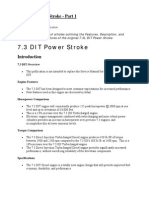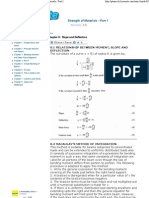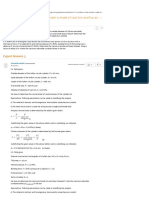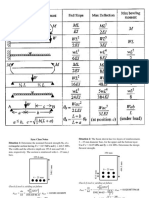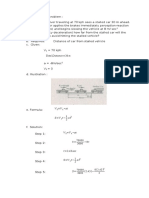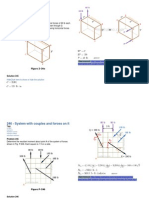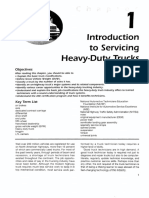Dynamics
Uploaded by
thines raveentraanDynamics
Uploaded by
thines raveentraanENT142/3 - ENGINEERING DYNAMICS (SEMESTER 2 - 2014/15 ACADEMIC SESSION)
ASSIGNMENT 2
Question 1
The mountain bike has a mass of 40 kg with center of mass at point G1, while the rider has a
mass of 60 kg with center of mass at point G2.When the brake is applied to the front wheel, it
causes the bike to decelerate at a constant rate of 3 m/s 2. Determine the normal reaction the
road exerts on the front and rear wheels. Assume that the rear wheel is free to roll. Neglect
the mass of all the wheels.
Figure 1
Question 2 (Chapter 7:18-40)
An automobile tire has a mass of 7 kg and a radius of gyration, kG = 0.3 m as shown in Figure
2.
(a) If it released from rest at A on the incline, determine its angular velocity when it reaches
the horizontal plane. The tire rolls without slipping.
(b) Redesign the automobile tire if the angular velocity in (a) needs to be increased doubly.
Figure 2
ENT142/3 - ENGINEERING DYNAMICS (SEMESTER 2 - 2014/15 ACADEMIC SESSION)
Question 3
Referring to Figure 3,
(a) if the cord is subjected to a horizontal force of P = 150 N, and the gear rack is fixed to the
horizontal plane, determine the angular velocity of the gear in 4 s, starting from rest. The
mass of the gear is 50 kg, and it has a radius of gyration about its center of mass O of kO =
125 mm.
(b) if the cord is subjected to a horizontal force of P = 150 N, and gear is supported by a fixed
pin at O, determine the angular velocity of the gear and the velocity of the 20-kg gear
rack in 4 s, starting from rest. The mass of the gear is 50 kg and it has a radius of gyration
of kO = 125 mm Assume that the contact surface between the gear rack and the horizontal
plane is smooth.
Figure 3
SOLUTION
ENT142/3 - ENGINEERING DYNAMICS (SEMESTER 2 - 2014/15 ACADEMIC SESSION)
Question 1
Question 2
(a)
(b)
ENT142/3 - ENGINEERING DYNAMICS (SEMESTER 2 - 2014/15 ACADEMIC SESSION)
Question 3
(a)
(b)
ENT142/3 - ENGINEERING DYNAMICS (SEMESTER 2 - 2014/15 ACADEMIC SESSION)
You might also like
- OSHA 30 Construction Final Test Answer Key71% (153)OSHA 30 Construction Final Test Answer Key74 pages
- OSHA 10 Hour General Industry Final Exam Answer Key75% (12)OSHA 10 Hour General Industry Final Exam Answer Key11 pages
- OSHA 10 Construction Final Exam Answer Key77% (13)OSHA 10 Construction Final Exam Answer Key18 pages
- Truck and Transport Mechanic-Practice Interprovincial Red Seal Exam80% (5)Truck and Transport Mechanic-Practice Interprovincial Red Seal Exam36 pages
- MaxxForce 7 Diesel Engine Repair & Service Manual - 043% (14)MaxxForce 7 Diesel Engine Repair & Service Manual - 014 pages
- DT 466 / DT 570 Diesel Engine Diagnostic Manual97% (37)DT 466 / DT 570 Diesel Engine Diagnostic Manual665 pages
- Moment Equation Using Singularity FunctionNo ratings yetMoment Equation Using Singularity Function42 pages
- Alert Indicators: Operation and Maintenance Manual100% (5)Alert Indicators: Operation and Maintenance Manual6 pages
- Structural Theory - Part 2b - Illustrative ProblemsNo ratings yetStructural Theory - Part 2b - Illustrative Problems14 pages
- Friction: Prepared By: Engr. Lucia V. Ortega 8/28/20No ratings yetFriction: Prepared By: Engr. Lucia V. Ortega 8/28/2021 pages
- Engineering Mechanics: Statics of Rigid BodiesNo ratings yetEngineering Mechanics: Statics of Rigid Bodies62 pages
- Basic Construction Materials: EngineeringNo ratings yetBasic Construction Materials: Engineering1 page
- Lesson 16 Stress Transformation (Mohr Circle)No ratings yetLesson 16 Stress Transformation (Mohr Circle)4 pages
- Resultant of Force Systems: Prepared By: Engr. Lucia V. Ortega 8/28/20 Statics of Rigid BodiesNo ratings yetResultant of Force Systems: Prepared By: Engr. Lucia V. Ortega 8/28/20 Statics of Rigid Bodies17 pages
- Chapter 8 Slope and Deflection Strength of Materials - Part 1No ratings yetChapter 8 Slope and Deflection Strength of Materials - Part 114 pages
- Revised Curriculum Cea Civil - Engineering Sy. 2018 2019No ratings yetRevised Curriculum Cea Civil - Engineering Sy. 2018 201916 pages
- Of The Bar by Equating The Strain: Problem 2.7-9No ratings yetOf The Bar by Equating The Strain: Problem 2.7-916 pages
- Mechanics of Deformable Bodies Midterm QuizNo ratings yetMechanics of Deformable Bodies Midterm Quiz6 pages
- Question: 5 A. A Hollow Circular Cylinder Is Made of Cast Iron and Has AnNo ratings yetQuestion: 5 A. A Hollow Circular Cylinder Is Made of Cast Iron and Has An2 pages
- Solution To Problem 612 - Double Integration Method - Strength of Materials Review at MATHalinoNo ratings yetSolution To Problem 612 - Double Integration Method - Strength of Materials Review at MATHalino4 pages
- Curvilinear Motion: Normal and Tangential Components (Section 12.7)No ratings yetCurvilinear Motion: Normal and Tangential Components (Section 12.7)28 pages
- Principles of Dynamics Students Hand OutsNo ratings yetPrinciples of Dynamics Students Hand Outs4 pages
- Statics of Rigid Bodies: Engineering MechanicsNo ratings yetStatics of Rigid Bodies: Engineering Mechanics35 pages
- Module 1 Chapter 1 Week 3 To Week 4 Dynamics of Rigid BodiesNo ratings yetModule 1 Chapter 1 Week 3 To Week 4 Dynamics of Rigid Bodies26 pages
- COPLANAR EQUILIBRIUM ANALYSIS Single and Composite BodiesNo ratings yetCOPLANAR EQUILIBRIUM ANALYSIS Single and Composite Bodies49 pages
- I Coplanar Concurrent Force Systems: Mass (M)No ratings yetI Coplanar Concurrent Force Systems: Mass (M)21 pages
- Rectilinear Motion: Variable AccelerationNo ratings yetRectilinear Motion: Variable Acceleration11 pages
- Numerical Methods and Implementation in Geotechnical Engineering – Part 1From EverandNumerical Methods and Implementation in Geotechnical Engineering – Part 1No ratings yet
- 3B5 Tutorial Week 9 - Forces in LinkagesNo ratings yet3B5 Tutorial Week 9 - Forces in Linkages4 pages
- Ultimate Survival Skills Handbook and Checklist100% (25)Ultimate Survival Skills Handbook and Checklist88 pages
- Transp Ortation 101:: Implementin GAN Effective Safet Y Progr AM100% (2)Transp Ortation 101:: Implementin GAN Effective Safet Y Progr AM9 pages
- Improving Your Self-Esteem: Information For ClientsNo ratings yetImproving Your Self-Esteem: Information For Clients12 pages
- Chapter 1 (Introduction To Servicing Heavy-Duty Trucks) 1No ratings yetChapter 1 (Introduction To Servicing Heavy-Duty Trucks) 116 pages
- Recovery From Nuclear Attack - FEMA 160.1988 PDF100% (1)Recovery From Nuclear Attack - FEMA 160.1988 PDF24 pages
- ASVAB Mechanical Comprehension Practice Test 3No ratings yetASVAB Mechanical Comprehension Practice Test 38 pages
- OSHA 10 Hour General Industry Final Exam Answer KeyOSHA 10 Hour General Industry Final Exam Answer Key
- Truck and Transport Mechanic-Practice Interprovincial Red Seal ExamTruck and Transport Mechanic-Practice Interprovincial Red Seal Exam
- MaxxForce 7 Diesel Engine Repair & Service Manual - 0MaxxForce 7 Diesel Engine Repair & Service Manual - 0
- Alert Indicators: Operation and Maintenance ManualAlert Indicators: Operation and Maintenance Manual
- Structural Theory - Part 2b - Illustrative ProblemsStructural Theory - Part 2b - Illustrative Problems
- Friction: Prepared By: Engr. Lucia V. Ortega 8/28/20Friction: Prepared By: Engr. Lucia V. Ortega 8/28/20
- Resultant of Force Systems: Prepared By: Engr. Lucia V. Ortega 8/28/20 Statics of Rigid BodiesResultant of Force Systems: Prepared By: Engr. Lucia V. Ortega 8/28/20 Statics of Rigid Bodies
- Chapter 8 Slope and Deflection Strength of Materials - Part 1Chapter 8 Slope and Deflection Strength of Materials - Part 1
- Revised Curriculum Cea Civil - Engineering Sy. 2018 2019Revised Curriculum Cea Civil - Engineering Sy. 2018 2019
- Question: 5 A. A Hollow Circular Cylinder Is Made of Cast Iron and Has AnQuestion: 5 A. A Hollow Circular Cylinder Is Made of Cast Iron and Has An
- Solution To Problem 612 - Double Integration Method - Strength of Materials Review at MATHalinoSolution To Problem 612 - Double Integration Method - Strength of Materials Review at MATHalino
- Curvilinear Motion: Normal and Tangential Components (Section 12.7)Curvilinear Motion: Normal and Tangential Components (Section 12.7)
- Module 1 Chapter 1 Week 3 To Week 4 Dynamics of Rigid BodiesModule 1 Chapter 1 Week 3 To Week 4 Dynamics of Rigid Bodies
- COPLANAR EQUILIBRIUM ANALYSIS Single and Composite BodiesCOPLANAR EQUILIBRIUM ANALYSIS Single and Composite Bodies
- Numerical Methods and Implementation in Geotechnical Engineering – Part 1From EverandNumerical Methods and Implementation in Geotechnical Engineering – Part 1
- Transp Ortation 101:: Implementin GAN Effective Safet Y Progr AMTransp Ortation 101:: Implementin GAN Effective Safet Y Progr AM
- Improving Your Self-Esteem: Information For ClientsImproving Your Self-Esteem: Information For Clients
- Chapter 1 (Introduction To Servicing Heavy-Duty Trucks) 1Chapter 1 (Introduction To Servicing Heavy-Duty Trucks) 1


















